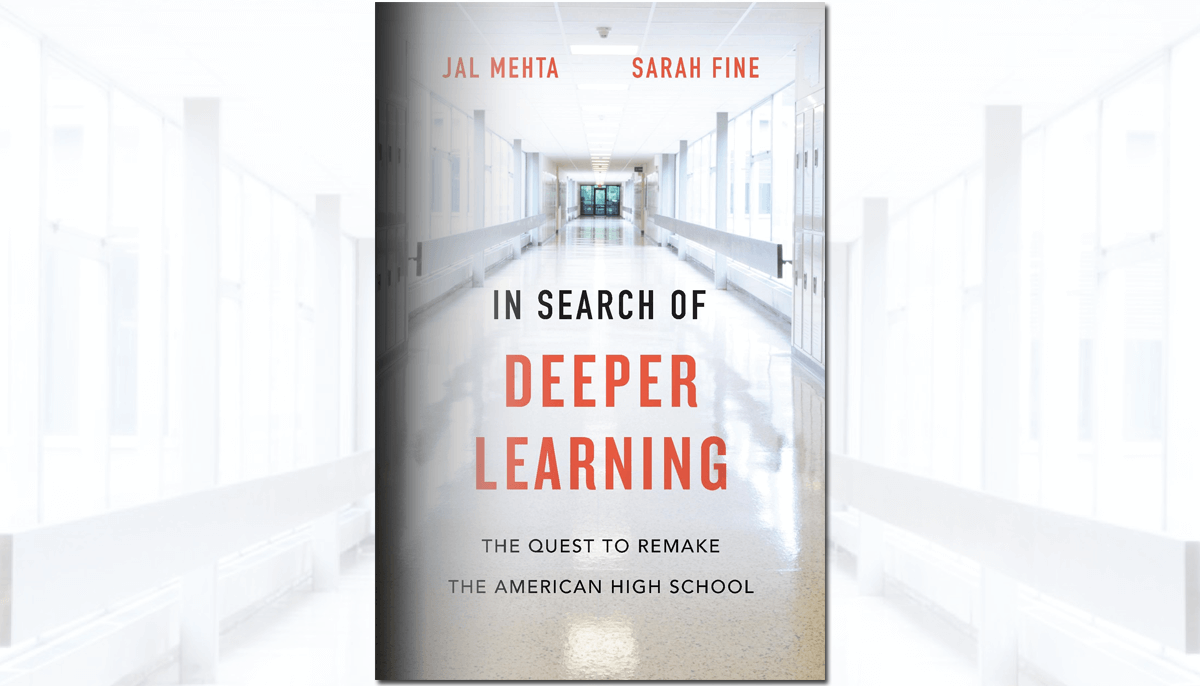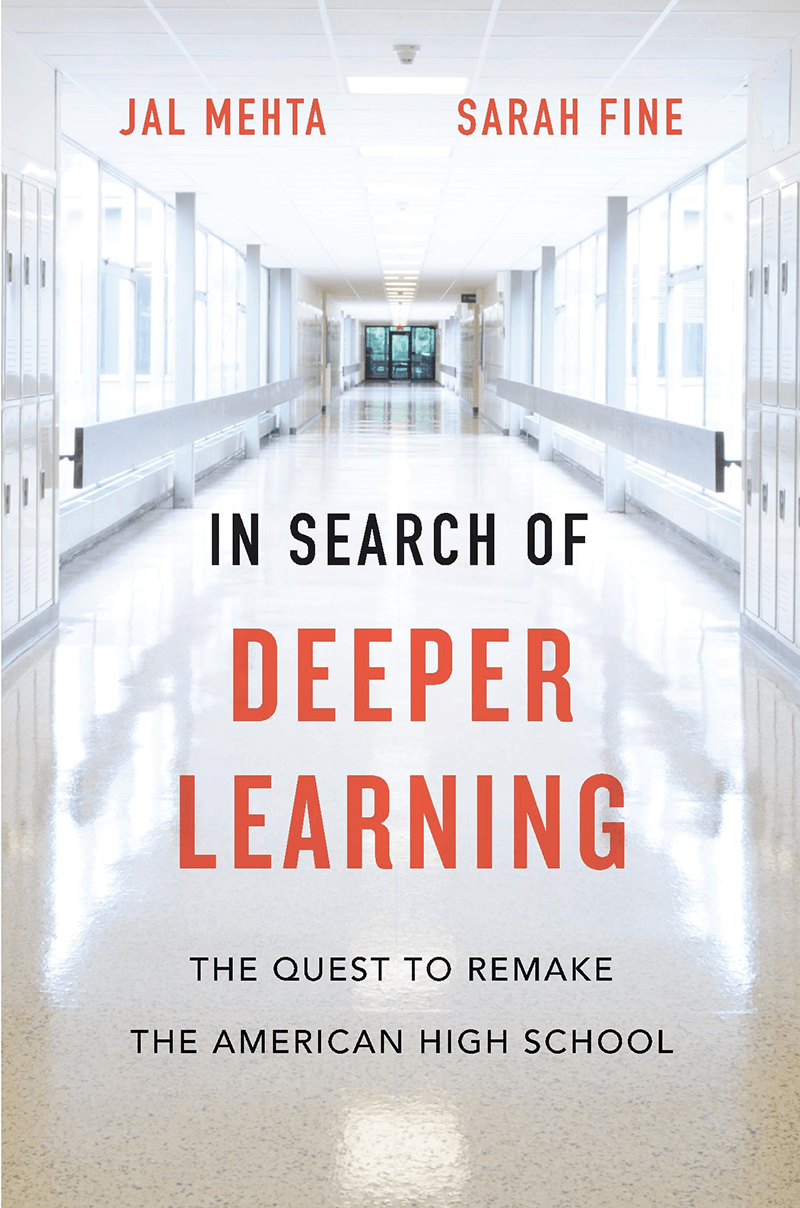
In Search of Deeper Learning: The Quest to Remake the American High School
by Jal Mehta and Sarah Fine
Harvard University Press, 2019, $29.95; 448 pages.
As reviewed by Eric Kalenze
Attempts to remake the public schools have been with us almost as long as the schools themselves. Regardless of the reinvention being pitched, the education “remakers” paint pictures of ideal learning environments where teachers empower students and ignite new interests, students relish challenges, and classrooms buzz with meaningful discussion and novel problem solving. If only schools would adapt themselves according to the would-be remakers’ recommendations, they would produce kids who both genuinely value their school experience and are better prepared for the world later.
Inspiring as these visions may be,history has shown that bringing them to fruition is more difficult than the reformers might envisage, in part because it is so difficult to define “success” in education. Measurement is even thornier. Confirming that kids are indeed growing into “better human beings,” for example, is far trickier than demonstrating that they’re growing academically. And attempts to make learning tasks more engaging can end up devouring time but doing nothing to improve results. Again and again, the education enterprise has turned back to practices whose desired outcomes are easier to define and target—and eventually, this retreat leads to a new cycle of education remaking.
In their new book, In Search of Deeper Learning, education professors Jal Mehta and Sarah Fine explore these tensions—though such an examination wasn’t their original goal. They started out hoping to study, understand, and showcase high schools that were bringing the visions of education remakers into reality: schools “that were not merely achieving academic minimums but helping students to flourish—to think critically, to become engaged in their learning, and, in a variety of ways, to prepare for the demands of twenty-first-century life.”
 Mehta, of the Harvard Graduate School of Education, and Fine, of High Tech High Graduate School of Education, went looking for “break-the-mold schools” where students were consistently experiencing “deep learning.” This they define as learning that emerges “at the intersection of . . . mastery (acquiring knowledge and skills), identity (learning that is seen as vitally connected to one’s self), and creativity (producing something new within a field).” The authors wanted to visit high schools that embraced different pedagogical approaches, governance styles, and designs. When they struck particularly rich veins of deep learning, they would try to understand how the school produced them, and share their insights with others.
Mehta, of the Harvard Graduate School of Education, and Fine, of High Tech High Graduate School of Education, went looking for “break-the-mold schools” where students were consistently experiencing “deep learning.” This they define as learning that emerges “at the intersection of . . . mastery (acquiring knowledge and skills), identity (learning that is seen as vitally connected to one’s self), and creativity (producing something new within a field).” The authors wanted to visit high schools that embraced different pedagogical approaches, governance styles, and designs. When they struck particularly rich veins of deep learning, they would try to understand how the school produced them, and share their insights with others.
The authors soon observed, however, that deep learning wasn’t happening very often or widely. Even when they investigated schools that were known for excellence and innovation, the authors “found gaps between aspirations and realities,” and “big ambitions” matched by “significant struggles”—teachers who did not fully understand, or just plain disagreed with, their charge within the innovative model; administrators who were unsure how to communicate expectations and build capacity around the new approaches; conflicting ideas about what school leaders were trying to accomplish; too much oversight from management, or not enough of it.
As the authors put it: “We were seeking inspiration; we found complexity.” So they decided to shift direction. Instead of searching for exemplary schools, they would explore those gaps between aspiration and reality. What obstacles to change arose, and why? Who had succeeded in overcoming some of them, and how?
Four High-School Models
Mehta and Fine looked closely at four distinct high-school models, which they present under the pseudonyms “Dewey High,” a progressive, project-based school; “No Excuses High,” emphasizing high academic standards and strict behavior rules; “IB High,” centered on the International Baccalaureate concept; and “Attainment High,” a comprehensive-model school. The authors devote a chapter to each approach, exploring how the model attempts to generate deep learning. Readers see into classrooms and extracurricular activities and hear administrators, teachers, and students talk about their professional and scholastic experiences: what works for them, what they struggle with, which classes and tasks they enjoy.
The authors succeed in creating a vivid picture of what goes on in many high schools, but one thing they de-emphasize is academic performance data. That’s because Mehta and Fine view this kind of assessment as but a small, and sometimes obscuring, way of measuring school quality. Yet the lack of data can’t help but detract from our understanding of “deep learning” and how it can be produced.
Still, the authors present the four school settings fully and fairly (though they clearly prefer more student-centered and progressive methods), acknowledging the pros and cons of each model. They note, for instance, that the project-based school achieves high student engagement but gets uneven results in developing basic skills. And they report that students from the no-excuses school say they appreciate what the school is doing for them but that “no one actually likes it here.”
They also dedicate significant space to describing student experiences and teacher methods that they judged had potential for facilitating deep learning. They spend several chapters exploring “instructional peripheries” (that is, electives, clubs, and extracurriculars) and zooming in on seven teachers they identified as doing some of the “deepest” teaching they observed. While these chapters have compelling elements, they suffer from logical flaws. For example, in the chapter on “instructional peripheries,” titled “Deeper Learning at the Margins,” they describe students willingly devoting time and energy to their various chosen activities and classes. But by definition, students follow their interests, passions, talents, and friends into those ventures. Student engagement is effectively built-in; thus, one cannot draw clean analogies between these elective pursuits and the required, often taxing subjects of the academic classroom.
Also, only one extracurricular activity is examined closely in this chapter: itis theater, at a school with a reputation for an outstanding theater program and director. Yet the skills and qualities that might be developed in drama class likely differ from what might be expected and cultivated in other “peripheral” activities. For example, expressing one’s self creatively is probably not valued as highly in athletics or news writing or the marching band as it is on the theater stage. The “authentic product that will matter to the student” looks different, depending on the activity, and sometimes the desired “product” is more related to precision, order, and, yes, rule following than are the theater experiences described in this chapter. Do other, more-structured peripheral experiences also provide “deep learning” opportunities, or just theater? Because these activities vary so widely, it’s difficult, if not impossible, to extrapolate.
Finally, the authors make some puzzling choices when it comes to singling out teachers for their ability to make deep learning experiences come to life. For instance, they describe “Ms. Peterson,” a science teacher at “Attainment High,” who is skilled at providing her students with highly engaging and exploratory engineering activities. The authors note that she came by this gift, in part, through a “seminal learning experience” that fundamentally changed how she thought about her domain and her students—an experience they say is common among teachers who enable deep learning. But Peterson’s seminal learning experience came via her work as an engineer, preceded by a master’s degree from Northwestern and a PhD from MIT. It therefore seems curious that the authors (and, indeed, Peterson) would turn up their noses at “traditional” teaching and learning. And there are several others like Peterson, from “Dr. Duchin,” a doctorate-holding constructivist science teacher, to “Mr. Fields,” a Zen priest and English teacher. In light of these teachers’ backgrounds, it is perplexing that the authors—and the teachers themselves—are as dedicated as they are to remaking traditional education.
The authors describe classrooms that are “alive with creativity and energy and enthusiasm,” and they cite students who say they feel validated as they get to “think like scientists.” But if mastery, identity, and creativity are the three sides of the deep-learning triangle, the authors leave too many unanswered questions about the “mastery” aspect. Nor do we discover whether or how students’ identities and creative abilities are being shaped.
These residual questions suggest a need for future research. They also imply that a longitudinal approach may be more effective in studying deep learning and what enables it. Classroom observation over periods of a few days coupled with student interviews constitutes a limited research method. Going forward, researchers may want to follow students who were taught in classrooms where they deem deep learning happened (preferably, as verified empirically or by multiple observers) to see how they fare in subsequent years—academically, socially, and emotionally.
The problem is, how do we verify that “deeper learning” has taken place? Until we can answer that question, it stands to reason that individual educators will interpret the concept differently and will only inconsistently produce the classroom conditions and experiences that can foster it. Future research could shed light on the matter by backward mapping from graduates who thrive in adulthood, and works like In Search of Deeper Learning at least provide a compelling set of places where education leaders and practitioners can start.
Eric Kalenze is the U.S. organizer of researchED, an international organization dedicated to building educators’ research literacy. His latest book, What the Academy Taught Us: Improving Schools from the Bottom Up in a Top-Down Transformation Era, will be released in fall 2019.
This article appeared in the Fall 2019 issue of Education Next. Suggested citation format:
Kalenze, E. (2019). Searching for Great High Schools: Education professors sought inspiration, found complexity. Education Next, 19(4), 84-85.


